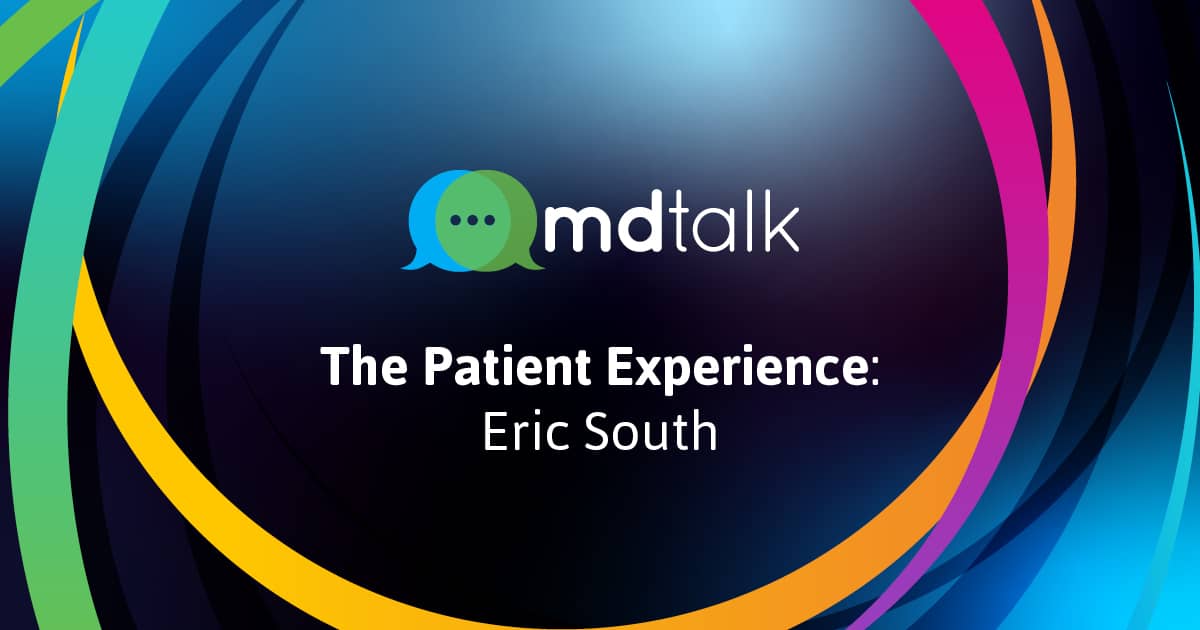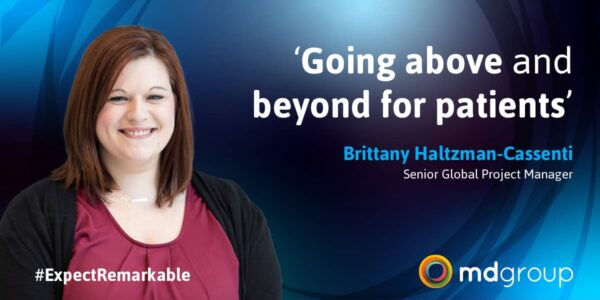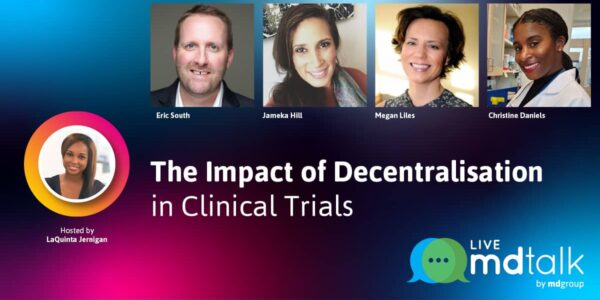
Welcome to another episode of mdtalk. Through this podcast and video series, we’re on a mission to highlight the most important issues impacting clinical research, trials and patient experience.
In this episode, we’re thrilled to welcome our special guest, Eric South. Eric is the founder of non-profit organisation The Gladiator Project, which connects families impacted by brain cancer with the support they need to fight the disease, as well as fundraising for research to find a cure.
We hear Eric’s remarkable story from his perspective as a patient and patient advocate – from receiving his diagnosis, to his experience of finding a clinical trial to enrol in, to the challenges and difficulties he faced during his participation.
We’ll also hear more about the story and mission behind The Gladiator Project, and how they’re currently working to support patients and families.
Episode Summary
Patients are critical to clinical trials. Yet currently, 85% of clinical trials fail to retain enough patients and more than two-thirds of trials fail to meet their goal due to patient dropouts. This means the endpoints needed to bring a drug to market aren’t met, with billions of dollars being lost along the way.
It’s estimated as many as 30% of patients drop out of trials for a variety of reasons, including travel issues, schedule conflicts, personal difficulties and financial constraints as well as feeling underappreciated, experiencing side effects or ill health, or expectations not being met.
Based on a recent survey asking study participants about their experiences, 35% of patients who dropped out of a study early reported it was difficult to understand the Informed Consent Form while 38% of patients who dropped out early felt site visits were stressful.
Diagnosis and finding a clinical trial
In February 2021, Eric was diagnosed with glioblastoma multiforme (GBM) – a stage four brain cancer for which there is no cure. Following surgery, he had conversations around what to do next and discovered the treatment journey and standard of care for GBM had remained unchanged for 15 years.
Eric wanted to know what options were available to take part in clinical trials, but finding the information he needed presented his first major challenge.
He told us: “Finding clinical trials is not easy. There are websites, but reading that as a non-medical person, it’s nearly indecipherable. We were fortunate enough to have a pediatric oncologist in our family that helped us navigate some of that. But without her, we really would have been lost.”
“Finding clinical trials is not easy. There are websites, but reading that as a non-medical person, it’s nearly indecipherable.”
Even once a trial is found, further challenges include having the right diagnosis to be accepted and finding opportunities at the right time. To secure his trial, Eric and his wife worked hard to find a connection and secure a referral, approaching as many oncologists as they could find.
Eric told us: “I come from a background in sales. I’ve always been aggressive with my career, so our approach was to interview as many oncologists as possible. I don’t think this is an approach most people would take, but that’s what we did.
“We interviewed doctors at MD Anderson, Sloan Kettering, Duke, Lenox Hill, Vanderbilt, all the reputable organizations. We wanted to find out who would give us the best chance, and whether they had a trial we could get into.
“It took a lot of bandwidth and energy. I was right out of brain surgery so I was not at 100%, my wife was tending to two children and still working and trying to handle everything. It was overwhelming.”
The burden on patients
When Eric was accepted on a clinical trial, things moved quickly. He suddenly had to be on-site in Texas, away from his family, for six consecutive weeks.
In addition to the logistical and financial challenge of finding somewhere to stay long term and close to the site, Eric had many more questions about participation and nowhere to turn for answers.
He said: “You start looking into the logistics with your family and who’s going to visit? How are the treatments going to affect me? Can I be on my own? I wasn’t authorized to drive at the time so, is there public transportation? Am I close enough that I could walk to the facility? Can I even walk after chemo and radiation? There are all these questions swirling in your mind. It’s a whirlwind.”
The burden of research and participation Eric found himself under was an immense challenge. He was newly diagnosed, recovering from surgery, with a wife and two kids and a full-time job. His story proves we have a long way to go as an industry to deliver truly remarkable patient-first experiences.
Thankfully, Eric and his wife Leslie had family and friends who could support them to care for the kids, allowing Leslie to visit him. But not all patients are in the same situation.
The clinical trial experience
Once Eric was enrolled on the trial, his treatment was rigorous – including chemotherapy and daily radiation treatments.
He was on-site for up to three hours a day and received almost 200 injections over the six-week period. It was physically and emotionally exhausting. But this is what gave Eric the motivation to start The Gladiator Project.
He told us: “I documented everything throughout my journey from day one to share with the world, or anybody who’s going through what I’m going through. What works and what doesn’t. The challenges, the obstacles, the opportunities.
“Emotionally, for me, thinking about helping other people helped me get through it. I’m not here for a pity party, I want to help others. That approach helped me emotionally to start The Gladiator Project, to know that I can create some good and help others going through what I’m going through at the same time.”
“Emotionally, for me, thinking about helping other people helped me get through it.”
When we asked Eric if he’d ever considered dropping out of the trial, he said: “I have not considered dropping out of the clinical trial that I’m in, but that doesn’t mean there aren’t challenges with it. I just had an MRI a week and a half ago, and it was clear. So for me, there would be no reason to consider backing out. My doctor is amazing, the nurses are heroes.
“But I will say this. If I weren’t texting with my research nurse on a daily basis, and being reminded of schedules and asking questions, and constantly being involved with my care. I don’t think I would even have been compliant with the protocol of the trial.”
Eric highlighted the need for more funding directed towards patient care in order to make clinical trial participation more accessible for more diverse populations: “There’s a lack of funding in clinical trials, and a lack of people to handle the coordination.
“I’m highly involved with my care, daily text messages, phone calls, emails, booking appointments, checking symptoms. I’m the one being responsible for doing that. And I don’t know that everybody can handle that.”
“I’m highly involved with my care, daily text messages, phone calls, emails, booking appointments, checking symptoms… And I don’t know that everybody can handle that.”
There is no doubt we have a responsibility as an industry to make sure funding and resources are there, so patients aren’t juggling being critically ill with the level of work required to participate in clinical research.
We must ensure that patient-centricity is not an empty phrase – it must become a way of life that the clinical research industry embraces.
What’s next for Eric?
Eric’s trial completes at the end of 2021. After that, he plans to continue his care with MD Anderson as their standard of care for visits and MRIs is every two months. Whereas this is every six months as an industry standard.
Eric told us: “It worries me for other people that they have to wait six months before they can go get a checkup. That’s not right. I guarantee every single one of those people would want to have more regular checkups on how things are progressing or not progressing inside of their head.”
“We want to help others, I want to help myself, and we want to find a cure for GBM.”
While continuing his care, Eric will also keep pushing on with his mission to support GBM patients to find the information they need and access support through The Gladiator Project.
He says: “I’ve brought on a board of directors that are way smarter than me, that have helped us put together an organization that’s set up to actually make a difference and help people. We can see great things on the horizon, how we’re going to directly impact patients, and directly impact research.
“We want to help others, I want to help myself, and we want to find a cure for GBM.”
Looking for more conversations?
For more content around key issues in the clinical research industry, follow us on social media on Twitter, find us on LinkedIn, and subscribe to our YouTube channel.
Please be assured, we have taken the utmost safety in filming this episode. We have fully vaccinated staff and ensured a negative COVID test prior to recording.



